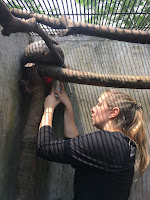Trip Summary

A summary of the trip in numbers.... 21 Pangolins in the care of SVW 11 Individuals with ongoing treatment of wounds (some for multiple wounds) 73 Wound treatments (same animals as above over multiple days) 42 Light therapy sessions 22 Wound dressings applied 100+ Doses of medication given (oral, injectable, eye drops) 100’s of 1000’s of butterflies seen 2 Snakes seen More spiders than I want to think about seen 3kg+ of rice consumed 108 Mosquito bites received (even with all the repellent in the world on!) Achievements of the trip... 1. To see a pangolin - tick! 2. To make a difference in animal conservation as a veterinary nurse - although on a small number of animals treated the improvement in wound healing with the light therapy was more than I could have hoped for. Thanks to Danetre to the donation of the machine so it can continue to make a difference! 3. Develop new skills and work outside of my comfort zone and my normal VN role - I can









